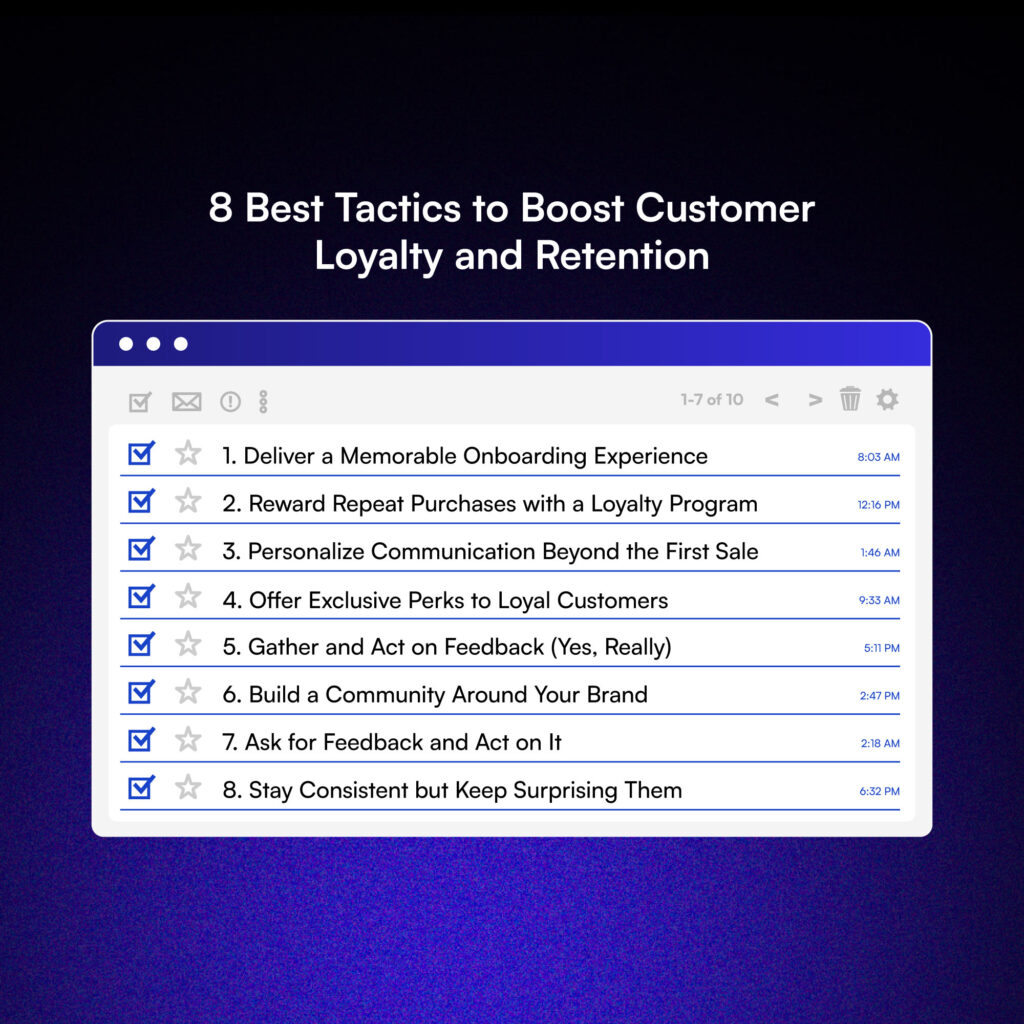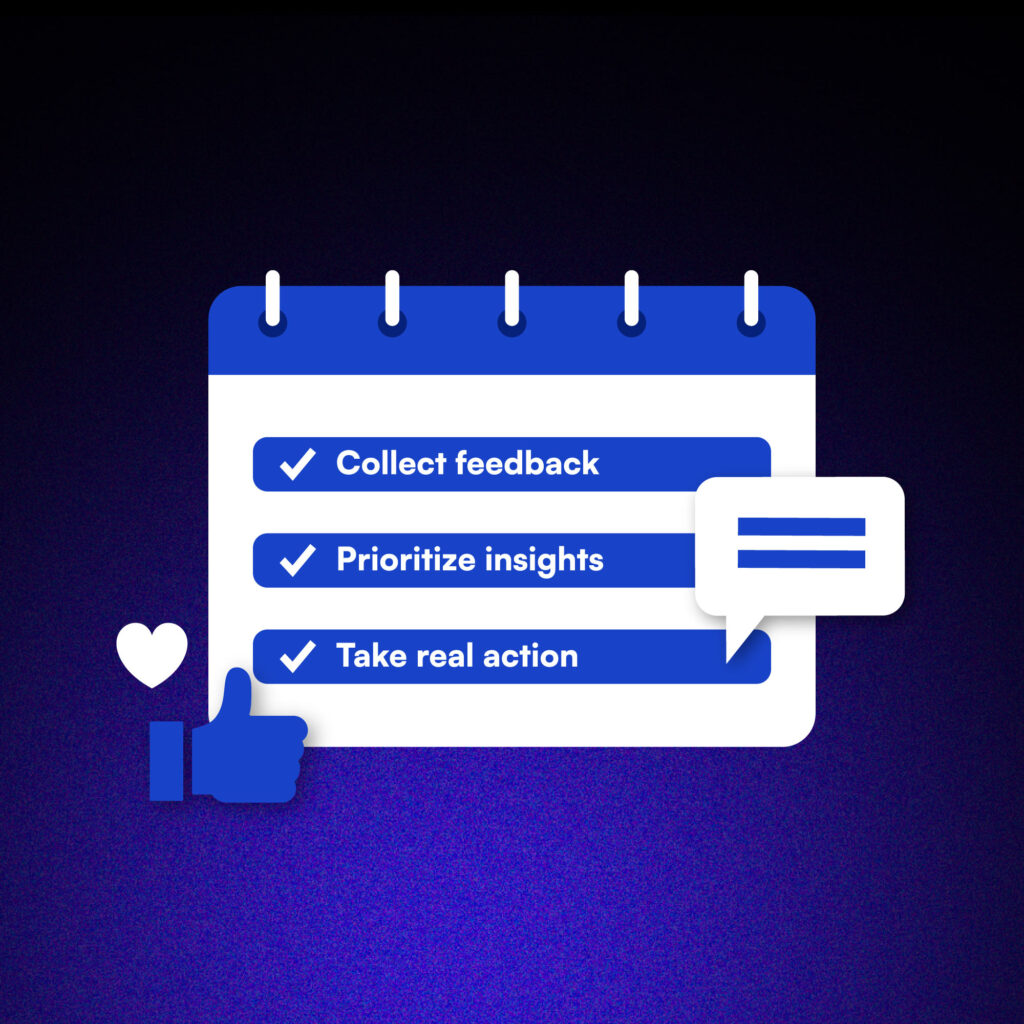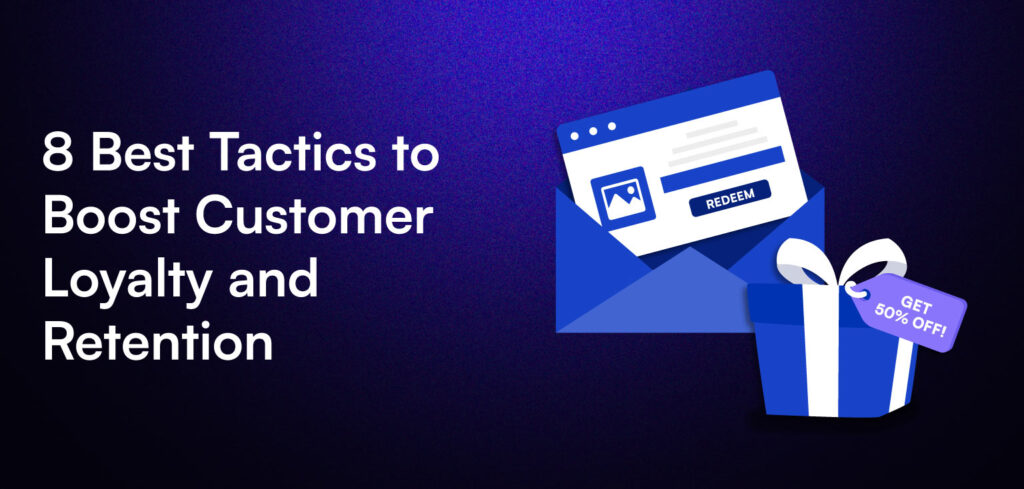Getting a customer to buy once is great, but getting them to return repeatedly is even better.
That’s where the real growth happens.
The truth is, it’s way more expensive to chase new customers than to keep the ones you already have. And yet, many brands still put most of their energy into acquisition instead of retention. That’s a missed opportunity. Loyal customers don’t just buy more as they spend more, refer others, and stick around even when your competitors wave flashy discounts.
But loyalty doesn’t just happen. It’s earned, and it takes the right tactics to build it for the long haul.
In this guide, we’re sharing the best tactics to boost customer loyalty and retention so you’re not just making sales but also building relationships.
Best Strategies to Boost Customer Loyalty and Retention

1. Deliver a Memorable Onboarding Experience
First impressions are everything. When someone makes their first purchase or signs up for your list, the onboarding experience sets the tone for your entire relationship.
And if all they get is a generic “Thanks for signing up,” you’re missing a golden opportunity.
A great onboarding sequence for customer loyalty and retention should do 3 things:
- Welcome the customer
- Guide them through their next steps
- Make them feel like they’ve made the right choice
That might look like this:
- A personalized thank-you email
- A short series explaining how to use the product
- An invite to join your community or rewards program
Think of it as your digital concierge service. You’re delivering confidence, clarity, and connection and not just focusing on the product.
Pro tip: Add a customer support CTA in your onboarding flow. “Need help getting started? We’re here for you,” goes a long way in building trust.
2. Reward Repeat Purchases with a Loyalty Program
If you want customers to come back again and again, give them a reason that feels exciting, not transactional. That’s where a well-crafted loyalty program shines.
The best customer loyalty and retention programs do more than just tally up points.
They make customers feel like insiders, like they’re part of something special. That could mean early access to new drops, exclusive content, or members-only perks.
Here’s what works:
- Simple earning and redemption rules (no confusing tiers)
- Tangible rewards that align with your brand
- Occasional surprises that make people smile
Example: “You’ve hit 100 points! That’s $10 off your next order plus early access to our spring collection.”
Pro tip: Send loyalty updates through email with personalized subject lines like “You’ve earned this!” or “Look what your points unlocked.”
3. Personalize Communication Beyond the First Sale
Most brands stop personalizing after the first transaction, and that’s a huge miss. Post-purchase personalization is what keeps people engaged, not just satisfied. Generic follow-ups like “We miss you!” won’t cut it.
Instead, use behavior and purchase data to send messages that actually matter.
Think:
- Product care tips or FAQs based on what they bought
- Recommendations that complement their last purchase
- Birthday emails or anniversary milestones
You’re showing them you’re paying attention, not just pushing another sale.
Example: “Still loving your [product]? Here’s how other customers are using theirs and a 10% thank-you for coming back.”
Pro tip: Set up dynamic content blocks in your emails to deliver unique content based on customer tags, last order date, or preferences.
4. Offer Exclusive Perks to Loyal Customers
Your most loyal customers shouldn’t feel like everyone else because they aren’t.
To boost your customer loyalty and retention, it’s your job to make customers feel like they’re part of something special when they keep coming back.
Exclusive perks can take many forms. Think VIP-only sales, early access to new products, sneak peeks, birthday surprises, or even a loyalty tier with better benefits. These types of offers make repeat customers feel rewarded, not just marketed to.
It’s not always about deep discounts, either. Sometimes, early access or a limited-edition item is more valuable than 10% off. The goal is to create a sense of privilege, a reason to stay close to your brand and keep engaging.
Pro tip: Use email segmentation to target your most active buyers with early-bird deals or limited-run items. Your best customers deserve the first look.
5. Gather and Act on Feedback (Yes, Really)

People like being heard, but they love it when brands listen. That’s why feedback loops are so powerful for customer loyalty and retention.
They show you’re not just talking to your customers; you’re talking with them.
Start simple: Send a follow-up email a few days after purchase asking how things went. Use quick surveys, thumbs-up/down buttons, or NPS scores to gather insights. You’ll find out what’s working and what needs work.
But here’s the key: Act on what you learn. If people complain about packaging, fix it, and then let them know. If customers love a product that’s always sold out, consider restocking or building a waitlist.
Pro tip: Share “You asked, we delivered” updates in your newsletter to close the loop and show customers that their input shapes your brand.
6. Build a Community Around Your Brand
The strongest brands don’t just have customers; they have fans. And fans stick around. Community gives people a reason to stay emotionally connected, not just transactionally engaged.
You can foster this in lots of ways: invite customers to share their stories, repost their social content, or spotlight them in your emails.
Run challenges or contests that encourage user-generated content.
Even a simple hashtag campaign can help create a sense of belonging.
Why does this matter?
Because people don’t churn on communities they care about.
They stay.
They tell friends.
They come back.
Pro tip: Create a “customer of the month” spotlight or feature user-generated content (UGC in your welcome series. When people see real customers celebrated, they’re more likely to engage themselves.
7. Ask for Feedback and Act on It
Your customers want to feel heard. Asking for feedback isn’t just polite, it’s a powerful loyalty tool when done right.
But here’s the key: Don’t just ask.
Show them you’re listening.
Start with a simple post-purchase email:
“How did we do?” or “Anything we could’ve done better?” You’d be surprised how many customers are willing to share if the ask feels genuine.
Then, actually use that input. Maybe someone said your checkout process was confusing or they couldn’t track their order. Fix it, and let them know you did. That kind of follow-through builds trust fast.
You can also share feedback wins in future emails.
Example: “You asked for easier returns. We made it happen. Here’s how.” It reminds customers they’re part of the journey, not just a sale.
Pro tip: Use short surveys with one-click responses to increase participation and add an open field for more detailed input.
8. Stay Consistent but Keep Surprising Them
Consistency builds trust, but a little surprise now and then builds love. Your email schedule, tone, and branding should always feel familiar. However, loyalty grows when customers feel appreciated in unexpected ways. Think birthday discounts, sneak peeks, or “just because” gifts.
Example:
“We noticed you’ve been with us for 6 months. Here’s something special.”
The best brands know how to make regular communication feel personal. Even a thoughtful subject line or a unique thank-you message can make someone smile,and keep them coming back.
And remember: consistency also means showing up. Send regular, valuable content, not just promos, and avoid disappearing for long gaps. Customers won’t stay loyal to a brand they barely hear from.
Pro tip: Build a retention calendar that includes both expected touchpoints (like renewal reminders) and surprise-and-delight moments throughout the year.
Your Next Move
customer loyalty and retention isn’t just about points or perks: it’s about giving people real reasons to come back. That means sending onboarding emails that don’t feel robotic. Rewarding repeat purchases without needing a punch card.
And keeping the conversation going after the sale instead of ghosting them. The best retention strategies feel invisible to the customer but are intentional to you.
You’re not flooding inboxes or shouting discounts. You’re reminding them why they liked your brand in the first place. These eight tactics aren’t silver bullets. But when done right, they turn “one-time buyers” into your most valuable customers and make retention feel a lot less like guesswork.


